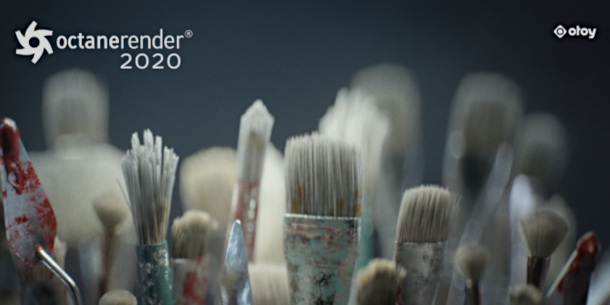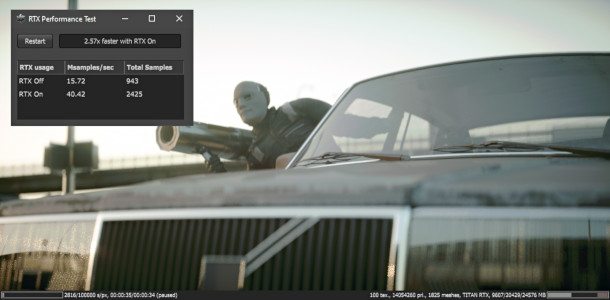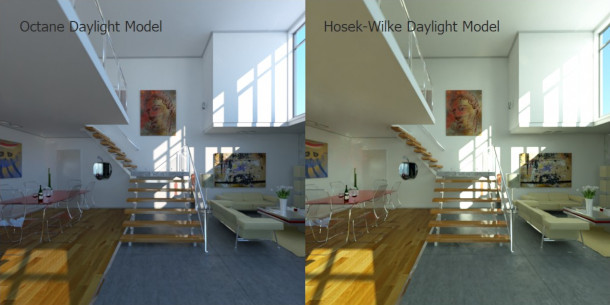Otoy ships OctaneRender 2020.1

Otoy has released OctaneRender 2020.1, a major update to its GPU production renderer, adding support for hardware-accelerated ray tracing on Nvidia GPUs, speeding up renders by “as much as 500%”.
Other new features originally previewed in OctaneRender 2019.2, but now reaching a stable build, include random walk subsurface scattering, a spectral hair material, and a new universal dirt system.
Users of the Cinema 4D integration plugin also get support for Cinema 4D’s native noise types; while Houdini users will be able to use OctaneRender as a viewport renderer within Houdini 18’s Solaris toolset.
Includes features originally previewed in OctaneRender 2019.2
Although Otoy originally released OctaneRender 2020.1 as a public preview in December 2019, several of its key features debuted much earlier, in OctaneRender 2019.2.
The first public preview of OctaneRender 2019.2 was released in March 2019, and although there was a further experimental build, it never reached a stable release, and was eventually rolled into 2020.1.

New hardware-accelerated ray tracing system: now based on Nvidia’s OptiX API
The key change in those 2019.2 builds – and also a cause of the delay – was the new hardware-accelerated ray tracing system, originally based on the open Vulkan GPU computing API.
The implementation was later switched to Nvidia’s OptiX API, due to “issues affecting VulkanRT [the Vulkan run-time libraries] that still need to be solved by third parties”.
That brings OctaneRender in line with other major renderers like Arnold and V-Ray, both of which now have hardware-accelerated ray tracing systems based on OptiX.
However, according to Otoy, enabling the new RTX mode can accelerate renders by “as much as 500%”: significantly higher than the speed boosts claimed by other developers.
The exact figure is scene dependent – as in other renderers, scenes with complex geometry but simple shaders should benefit most – and the implementation is currently only optimised for triangular meshes.
Optimisations for non-tri meshes, including splines and rounded edges, should follow in 2020.2.
Despite its name, the new RTX mode should work with older Nvidia GPUs, though to get the most out of it, you will need a current-gen RTX card, which feature dedicated ray tracing cores.
However, it is only available to Windows and Linux users: Otoy has also announced Octane X, a separate new edition of the renderer for macOS accelerated via Apple’s Metal API, which is currently in closed beta.
Also previewed in 2019.2: random walk subsurface scattering, new spectral hair material
Other features originally previewed in OctaneRender 2019.2 include random walk subsurface scattering – also now supported in many other render engines – and a new spectral hair material.
The release also marked the debut of the new ‘universal dirt system’: an update to OctaneRender’s dirt texture node with “additional parameters for better flexibility”.

Entirely new in 2020.1: Hosek-Wilkie daylight system, OCIO-based colour management
Entirely new features in OctaneRender 2020.1 include a daylight system based on the Hosek-Wilkie model.
According to Otoy, it produces “more realistic and detailed results than other implementations specially in hazy conditions and near the horizon”.
Other new features include an OpenColorIO-based display colour management system, with the option to import ICC and ICM profiles for monitors; and the option to export ACES OpenEXR files.
The universal camera introduced in OctaneRender 2019.1 has been extended, including new depth of field options, plus support for optical vignetting and split-focus diopter effects.
The rounded edge shader and handling of particle attributes have also been updated: you can find details via the links at the foot of the story.
In addition, a set of new OSL procedural shaders has been added to OctaneRender’s LiveDB material library.
New in individual plugins: support for native Cinema 4D noise types, Houdini Hydra render delegate
Outside the standalone edition of the renderer, new features due in OctaneRender 2020.1 include support for Cinema 4D’s native noise types, both as 2D textures and to modify 3D volumes.
Scenes containing native Cinema 4D noises can also be exported in Otoy’s ORBX file format and rendered in the standalone edition of the renderer.
Houdini users will get a new Hydra render delegate, enabling them to use OctaneRender as a viewport renderer within Solaris, Houdini 18‘s new look dev and shot layout toolset.
The Hydra delegate is “[a separate] project not related directly to the main Houdini plugin” and will be available to users “shortly”, but GPU noises are supported in the latest version of the Cinema 4D plugin.
Pricing and system requirements
OctaneRender 2020.1 is available for 64-bit Windows 7+, Linux and macOS 10.12+. Integration plugins are available for 21 DCC applications.
The core software requires a CUDA 10-capable Nvidia GPU. The new RTX rendering mode requires Nvidia Studio Driver 4.35.80+ for Windows or 435.12 for Linux.
Enterprise box licences – perpetual licences for the standalone edition and one integration plugin, plus subscription access to the remaining plugins – currently start at €699 (around $750).
Subscriptions give access to all of the plugins and cost €19.99/month or €199/year ($21/month or $215/year) for use on up to two GPUs, or €29.99/month or €299/year ($32/month or $324/year) for unlimited GPUs.
The Blender, DAZ 3D, Unity and Unreal Engine plugins are available free for use on a single GPU via OctaneRender Prime. Prime does not include OctaneRender standalone, or support network rendering.
Read an overview of the new features in OctaneRender 2020.1 on Otoy’s forum
Read more about the new features in OctaneRender in the online documentation
(Note: not updated to OctaneRender 2020.1 at the time of posting)
